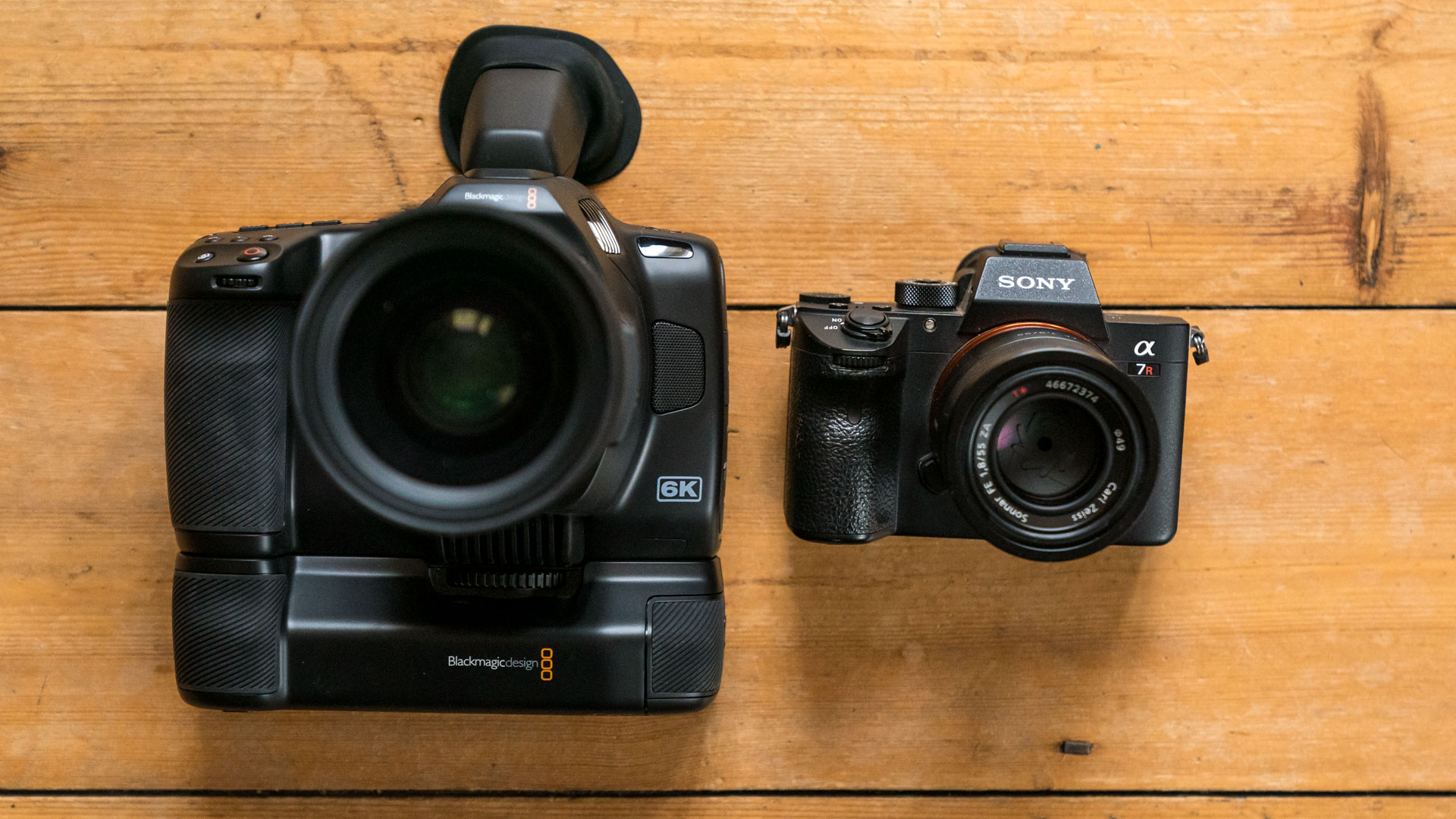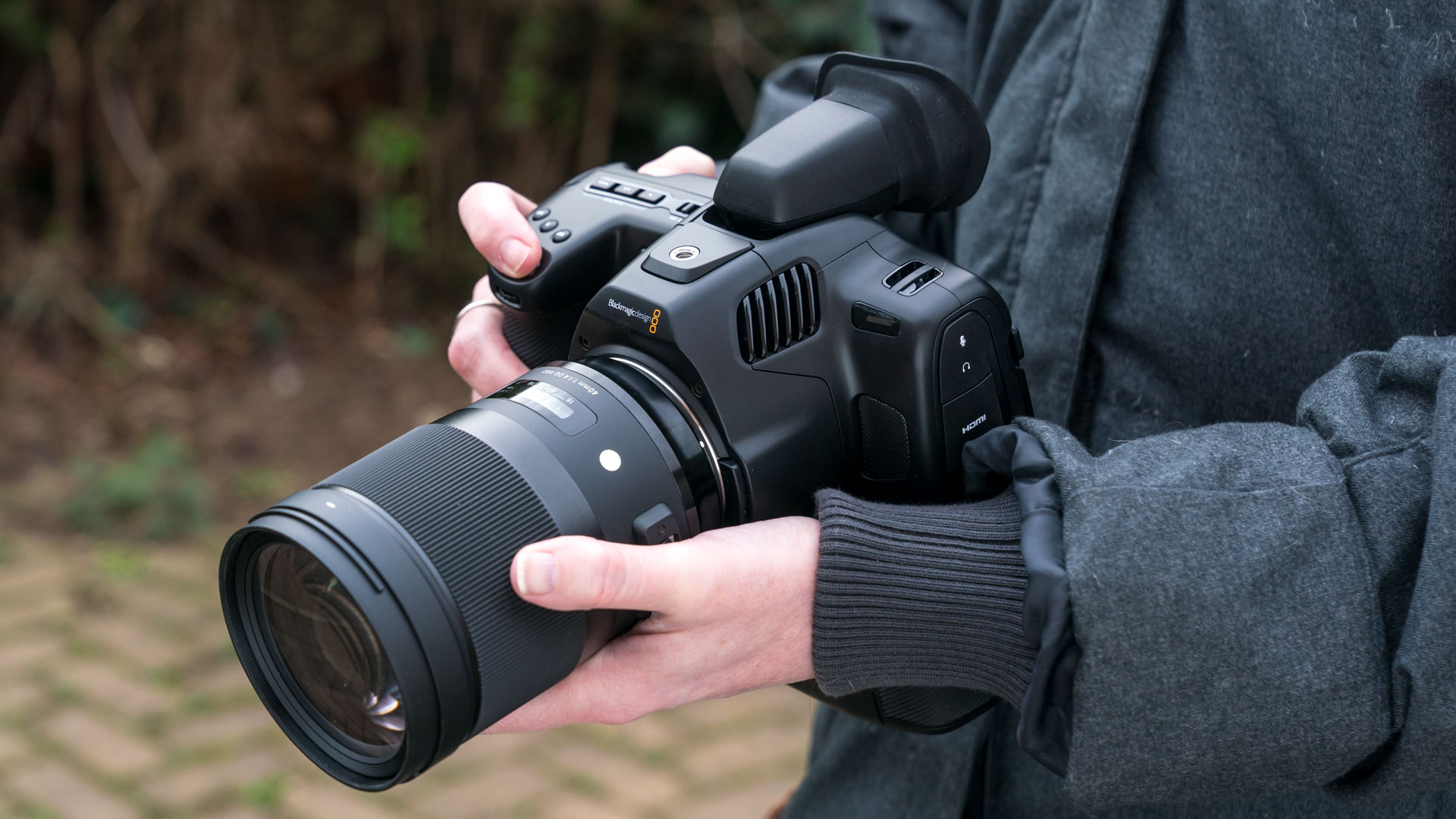Digital Camera World Verdict
First of all, you have to get used to the handling from the odd size and large shape of the Super35mm Blackmagic Pocket Cinema Camera 6K Pro – which is certainly far from being pocket size. And the lack of continuous autofocus, image stabilisation or any auto-exposure can be an issue for some. It’s definitely not a run and gun camera. But if you use it as a tool for considered, cinematic shooting then it’s a bit of a steal as it produces rich, detailed files in Raw or ProRes from its dual native ISO sensor.
Pros
- +
Great value for the spec
- +
Built-in ND filters
- +
Blackmagic Raw and ProRes
Cons
- -
It’s not a small camera!
- -
No continuous AF, AE or IBIS
- -
Screen is tilt-only
Why you can trust Digital Camera World
The Blackmagic Pocket Cinema Camera 6K Pro is a development of the original 6K model, which saw the Aussie firm move away from using the small MFT sensor into the big league with a much better Super35mm sensor, which needed a new lens mount. Blackmagic went for Canon EF, and there are lots of lenses available at all budgets and in all styles, from bargain, AF nifty 50s to premium cinema primes and everything in between.
With its large but fixed five-inch rear screen, internal 12-bit Blackmagic Raw as well as 10-bit ProRes codecs, the original BMPCC 6K was a fine video camera that went a long way towards being a professional filmmaking tool. It had lots of the bells and whistles that filmmakers like, but a couple of obvious omissions such as built-in ND filters and any sort of EVF. To get a viewfinder to fit meant an investment in an external EVF and some sort of rigging to fasten it to. And you’d have to get the signal to it via HDMI. That adds a lot of expense, hassle and takes up the HDMI output.
So Blackmagic worked its hocus-pocus and the new Pro version of the camera comes with a tilting rear screen, built-in ND filters and an optional EVF that slots onto the top plate once you remove a blanking panel. This costs £510 but it’s a lot cheaper, smaller and neater than any other external EVF. The camera itself hasn’t seen a price hike for these new features, either.
The 6K Pro now uses Sony-fit NP-F batteries and also accepts an optional £138 battery grip that screws onto the bottom plate, once you remove a blanking plate there. This allows for two batteries, but makes the camera even bigger. In this configuration it even dwarfs a pro DSLR or medium format stills camera. It’s a beast.
The camera also has improved colour science, too, as well as a USB-C port to keep the camera charged up while you’re using it.
Specifications
Sensor: 23.1x12.99mm Super35 CMOS
Image stabiliser: None
ISO range: 100-25,600. Dual Native ISO 400/ 3200
Dynamic range: 13 stops
Lens mount: Canon EF
LCD: 127mm/ 5in LCD touchscreen, 1920x1080
Viewfinder: Optional
Auto focus: Contrast detect, one-shot
Recording format: Blackmagic Raw 6K 6144x3456 50p/ 30p/ 29.97p/ 25p/ 24p/ 23.98p 49-483Mbps, 6144x2560, 5744x3024 60p/ 59.94p/ 50p/ 30p/ 29.97p/ 25p/ 24p/ 23.98p 37-395Mpbs. ProRes 422HQ, 422, 422LT, 422 Proxy, DCI 4K 4096x 2160, 4K 3840x2160 60p/ 59.94p/ 50p/ 30p/ 29.97p/ 25p/ 24p/ 23.98p 22.2-118Mpbs. 2.8K 2868x1512, FHD 1920x1080 120p/ 60p/ 59.94p/ 50p/ 30p/ 29.97p/ 25p/ 24p/ 23.98p 5.6-27.5Mbps. 3.7K 3623x3020 anamorphic 60p 2.4:1.
Connectivity: USB-C, HDMI, mini XLR, 3.5mm stereo input for mic and timecode, Bluetooth
Storage: 1x CFast, 1x SDXC UHS-II slot
Battery: Sony NP-F
Dimensions (WxHxD): 179.8x112x122.9mm
Weight: 1,238g
Key features
The heart of the camera is Blackmagic’s Super35mm CMOS sensor with dual native ISO. This shoots up to 6K in Blackmagic’s own Raw format in 6K and 6K 2.4:1, 5.7K in 17:9, C4K, 4K, 3.7K anamorphic and 2.8K in 17:9. If you choose ProRes, then you can record in C4K, 4K or FHD. The fastest frame rate is 60fps with off-speed frame rates allowed. That’s something Hollywood cinematographers are used to but of limited use to most independent filmmakers or hobbyists, apart from going slow for creative, blurry effects.
The best camera deals, reviews, product advice, and unmissable photography news, direct to your inbox!
There is 120fps slow-motion in 2.8K 17:9 Raw or in HD ProRes scaled from 2.7K. The crop in 120fps in 3.388x, which is a huge amount. It might work for you in shooting some sport or wildlife, though, as it gives your lenses a huge reach but at the expense of image quality.
One issue around the older 6K camera was battery life from its Canon LP-E6 cells and you’d definitely need to carry a pocketful of them for day’s shooting day.
It now takes Sony-spec batteries which can be bought in larger capacities, but it’s still power-hungry and you should buy a few – even if you use the battery grip. The camera can be trickle charged by the USB-C socket but only if you’re not using it to record to an external SSD.
There is an input for mains power which takes a very secure push fitting, ideal for use on film sets for extended use. In fact, the whole camera plays very well with Blackmagic’s live broadcast and streaming ecosystem.
Like all recent versions of the Pocket Camera including the 4K version, the dual-native ISO is good for low-light and 13 stops of dynamic range are ideal for HDR images. There is a full-size HDMI socket, a mini-XLR input with phantom power for professional mics, built-in LUTs, plus timecode and zebra pattern for monitoring.
The left side of the camera has rubber covers over ports that include a headphone socket and mini XLR jack. And there are good-quality internal mics and preamps, too, with on-screen audio monitoring that is easy to see. The HDMI socket gives a clean 10-bit output and support for HDR. The camera uses a CFast card so you can record everything internally, though.
The older Pocket Cinema Camera 6K had a fixed rear screen, while the Pro model tilts – just as everyone else goes to fully articulating screens.
Build and handling
When you think of carbon fibre composite, most people conjure up visions of the chequerboard weave pattern found on everything from Formula One cars to posh tripods. The Blackmagic Pocket Cinema Camera 6K has a carbon fibre body but it doesn’t feel particularly premium. Quite the opposite, in fact. It’s also very wide and when fitted with the battery grip, won’t stand up on a flat surface without falling over forward when you put a lens on it.
However, the controls are well-designed with a large Rec button and an obvious control dial on the front to adjust aperture. There are clear buttons to change ISO and white balance, and three customisable function buttons ideal for false colour, the effect of the display LUT and frame guidelines.
On the back of the camera are two very useful buttons. One is an instant auto exposure button and the other an autofocus button which uses the slow and old-school contrast-detect AF system.
You have to think of the camera really as a manual focus and manual exposure device, but a quick push of the AE and AF buttons usually gets your focus and aperture in the ballpark. Once you get used to it, it’s very useful. But it's nothing compared to having continuous AF that tracks a moving subject. To achieve that with this camera, you need to be incredibly good at focus pulls.
There is a punch-in focus button to give you an enlarged view of the scene, and a high frame rate recording button. Plus the menu button and the playback button.
The large touchscreen menu is clear and well designed. It allows you to change settings including shutter speed or shutter angle. Once shooting, the main info is all around the outside of the screen or you can turn it off for a clear view. It’s a shame there are no waveforms on the screen, though, only a histogram.
The new viewfinder is a 1280 x 960 colour OLED display with a 70-degree swivel range. It comes with four different types of eyecups for both left and right eyes, but these fall off very easily. The view isn’t great and for the asking price, it’s not particularly impressive. But when you must use a viewfinder such as in bright sunshine, you now can.
Performance
Once you experience the ultimate quality of shooting in Raw, it’s difficult to accept anything less. There is a real edge in quality and control that only Raw files gives, but it comes at a cost. One is the extra processing involved and these Blackmagic Raw (B-Raw) files have to be processed in Blackmagic’s own Da Vinci Resolve software. You do get a free, full Studio version of Resolve included, which is industry-standard for colour grading.
Here is a sample video:
The other issue in Raw is the usually massive file sizes. However, the 6K Pro allows you to select different compression levels for its Raw files from 3:1 right down to 12:1 if you keep the bitrate constant, or four quality levels from Q0 to Q4 if you want consistent quality. Either way, this offers a balancing act between file size and quality. Shoot in 6K and even the most compressed files give stunning resolution. At 6K you can get around an hour of recording time on a 256GB card.
Recording 4K or lower in ProRes gives edit-ready files that are easier to handle, and usually save on space compared to Raw. But with a choice of different compression levels, some of the more robust 10-bit ProRes files are actually bigger than some of the 12-bit B-Raw files.
If you want more resolution than C4K, then you have to shoot Raw and this gives a real advantage, as you can alter white balance and pull back shadow and highlight details far more effectively. But 10-bit ProRes files are also incredibly detailed, too.
The Pro model now has the fifth Generation colour science as the high-end Blackmagic cameras, which gives very realistic colours. The camera offers three different sorts of colour settings – from standard video through to much more filmic – and you can upload your own LUTs too. And thanks to the Dual Native ISO sensor, there is very low noise. Overall, the image quality is excellent, especially if you take the time to shoot Raw and grade it properly.
Verdict
If you fancy the Blackmagic Pocket Cinema Camera 6K Pro for run-and-gun documentaries or shooting sports and wildlife, it’s really not the best choice. There is no workable autofocus or image stabilisation, the 120fps is hugely cropped, the battery life still isn’t that great, the file sizes are big and it’s just a huge camera.
But if you want to shoot beautifully cinematic footage in stunning quality that can be graded to within an inch of its life, with shallow depth-of-field from the Super35mm sensor, then it makes a lot of sense. Especially at the relatively affordable asking price. It seems 6K is fast becoming the new norm.
Read more:
• Best cinema cameras
• Best cameras for filmmaking
• Blackmagic Pocket Cinema 6K
• Blackmagic Pocket Cinema 4K
• Blackmagic Ursa Mini Pro 12K
• Best cine lenses
Adam Duckworth is an award-winning professional photographer and videographer based in the UK. He has worked for many top magazines, newspapers and corporate clients for more than 25 years. He was named SWPP UK Commercial Photographer of the Year, and is an Associate of the British Institute of Professional Photography. He has also worked for international publications like Motor Cycle News, Racer X, The Sunday Times, The Guardian, ZOO, Golf World, Today's Golfer, and Mountain Bike Action, among others.









